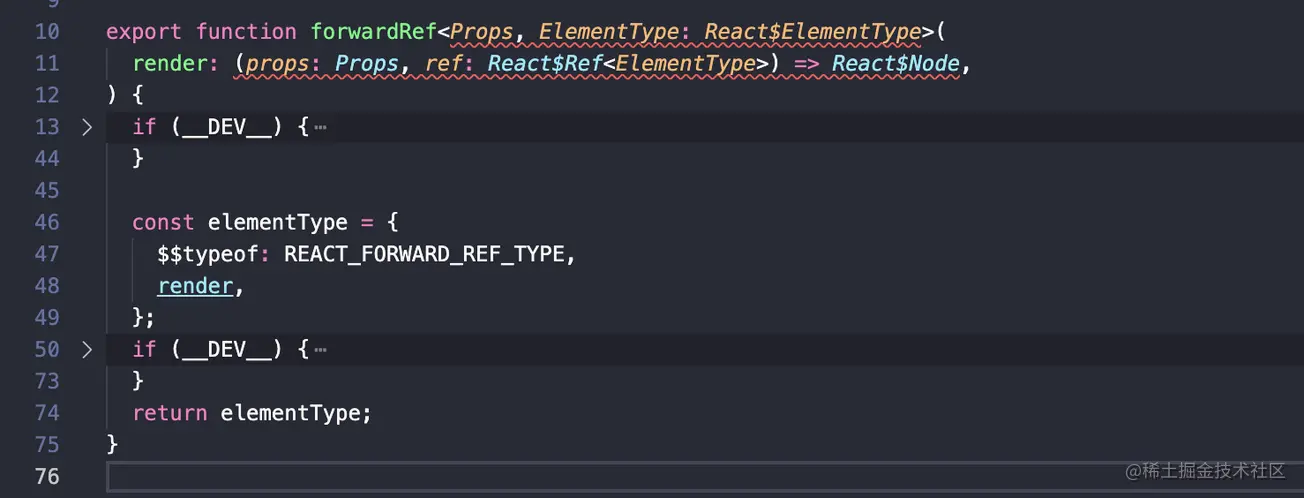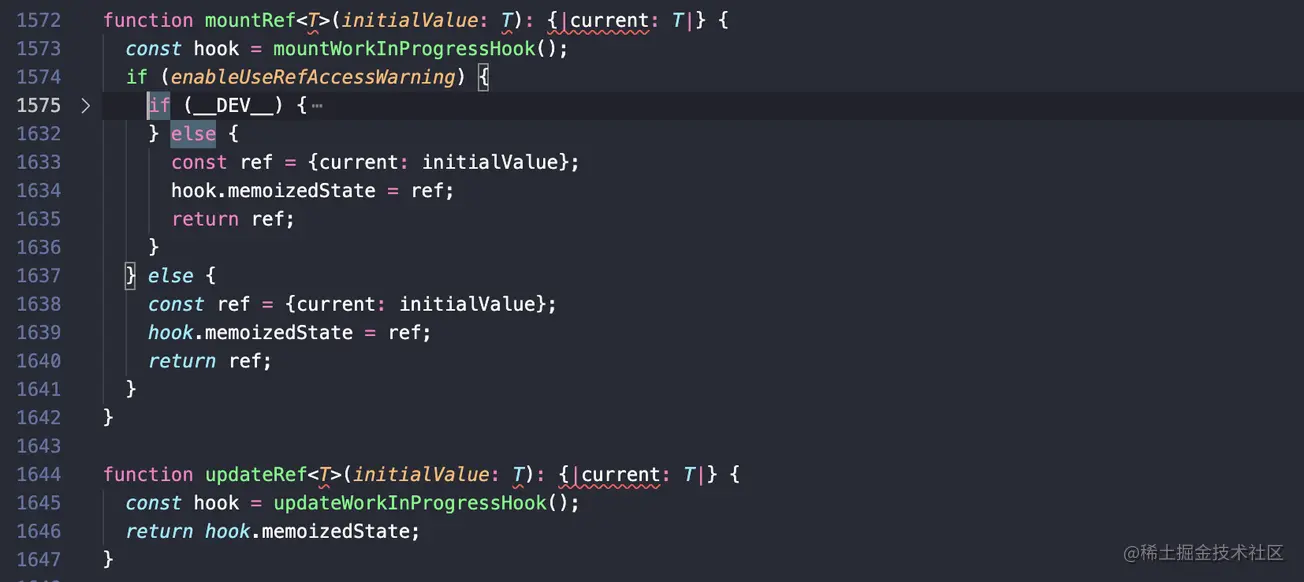 Web Front-end
Web Front-end
 JS Tutorial
JS Tutorial
 Let you understand Ref in React and share knowledge points worth knowing.
Let you understand Ref in React and share knowledge points worth knowing.
Let you understand Ref in React and share knowledge points worth knowing.
This article will take you to understand Ref in React and introduce some knowledge points you need to know about Ref. I hope it will be helpful to everyone!

Intro
In React projects, there are many scenarios where Ref is needed. For example, use the ref attribute to obtain the DOM node and obtain the ClassComponent object instance; use the useRef Hook to create a Ref object to solve problems such as setInterval not being able to obtain the latest state. Question; you can also call the React.createRef method to manually create a Ref object. [Related recommendations: Redis Video Tutorial]
Although Ref is very simple to use, it is inevitable to encounter problems in actual projects. This article will From the perspective of source code, sort out various issues related to Ref, and clarify what is done behind the APIs related to ref. After reading this article, you may have a deeper understanding of Ref.
Ref related type declaration
First of all ref is the abbreviation of reference, which is a reference. In the type declaration file of react, you can find several types related to Ref, and they are listed here.
RefObject/MutableRefObject
interface RefObject<T> { readonly current: T | null; }
interface MutableRefObject<T> { current: T; }When using useRef Hook returns RefObject/MutableRefObejct. Both types define a { current: T } object structure, the difference is that the current property of RefObject is read-only. If refObject.current is modified, Typescript will warn⚠️.
const ref = useRef<string>(null) ref.current = '' // Error
TS Error: Cannot assign to "current" because it is a read-only property.

View the definition of the useRef method. Function overloading is used here. When passing in generic parameters T will return RefObject<T> when it does not contain null, and MutableRefObject<T>## when it contains null. #.
function useRef<T>(initialValue: T): MutableRefObject<T>; function useRef<T>(initialValue: T | null): RefObject<T>;
| null.
const ref = useRef<string | null>(null) ref.current = '' // OK
React.createRef() method, it also returns a RefObject.
export function createRef(): RefObject {
const refObject = {
current: null,
};
if (__DEV__) {
Object.seal(refObject);
}
return refObject;
}RefObject/MutableRefObject was added in version 16.3, if you use an earlier version , need to use Ref Callback.
RefCallback
UsingRef Callback is to pass a callback function. When react calls back, the corresponding instance will be passed back. You can save it yourself for convenience. transfer. The type of this callback function is RefCallback.
type RefCallback<T> = (instance: T | null) => void;
RefCallback Example:
import React from 'react'
export class CustomTextInput extends React.Component {
textInput: HTMLInputElement | null = null;
saveInputRef = (element: HTMLInputElement | null) => {
this.textInput = element;
}
render() {
return (
<input type="text" ref={this.saveInputRef} />
);
}
}Ref/LegacyRef
In the type declaration, there is also the Ref/LegacyRef type , they are used to refer to Ref types generally.LegacyRef is a compatible version. In the previous old version, ref can also be string.
type Ref<T> = RefCallback<T> | RefObject<T> | null; type LegacyRef<T> = string | Ref<T>;
Special props
When usingref on a JSX component, we pass ## The #ref attribute sets a Ref. We all know that the syntax of jsx will be compiled into the form of createElement by tools such as Babel. <div class="code" style="position:relative; padding:0px; margin:0px;"><pre class='brush:php;toolbar:false;'>// jsx
<App ref={ref} id="my-app" ></App>
// compiled to
React.createElement(App, {
ref: ref,
id: "my-app"
});</pre><div class="contentsignin">Copy after login</div></div>It seems that
is no different from other props, but if you try to print props.ref inside the component, it is undefined. And the dev environment console will give a prompt.
undefinedbeing returned. If you need to access the same value within the child component, you should pass it as a different prop.
</blockquote><p>React 对 ref 做了啥?在 <a href="https://github.com/facebook/react/blob/dbe9e732af1f12757a55adb12a8279d7db898b60/packages/react/src/ReactElement.js#L16" target="_blank" rel="nofollow noopener noreferrer" ref="nofollow noopener noreferrer">ReactElement</a> 源码中可以看到,<code>ref是RESERVED_PROPS,同样有这种待遇的还有key,它们都会被特殊处理,从 props 中提取出来传递给Element。const RESERVED_PROPS = { key: true, ref: true, __self: true, __source: true, };Copy after login所以
ref是会被特殊处理的“props“。forwardRef
在
16.8.0版本之前,Function Component 是无状态的,只会根据传入的 props render。有了 Hook 之后不仅可以有内部状态,还可以暴露方法供外部调用(需要借助forwardRef和useImperativeHandle)。如果直接对一个
Function Component用ref,dev 环境下控制台会告警,提示你需要用forwardRef进行包裹起来。function Input () { return <input /> } const ref = useRef() <Input ref={ref} />Copy after loginFunction components cannot be given refs. Attempts to access this ref will fail. Did you mean to use React.forwardRef()?
forwardRef为何物?查看源码 ReactForwardRef.js 将__DEV__相关的代码折叠起来,它只是一个无比简单的高阶组件。接收一个 render 的 FunctionComponent,将它包裹一下定义$$typeof为REACT_FORWARD_REF_TYPE,return回去。
跟踪代码,找到 resolveLazyComponentTag,在这里
$$typeof会被解析成对应的 WorkTag。
REACT_FORWARD_REF_TYPE对应的 WorkTag 是 ForwardRef。紧接着 ForwardRef 又会进入 updateForwardRef 的逻辑。case ForwardRef: { child = updateForwardRef( null, workInProgress, Component, resolvedProps, renderLanes, ); return child; }Copy after login这个方法又会调用 renderWithHooks 方法,并在第五个参数传入
ref。nextChildren = renderWithHooks( current, workInProgress, render, nextProps, ref, // 这里 renderLanes, );Copy after login继续跟踪代码,进入 renderWithHooks 方法,可以看到,
ref会作为Component的第二个参数传递。到这里我们可以理解被forwardRef包裹的FuncitonComponent第二个参数ref是从哪里来的(对比 ClassComponent contructor 第二个参数是 Context)。
了解如何传递 ref,那下一个问题就是 ref 是如何被赋值的。
ref 的赋值
打断点(给 ref 赋值一个 RefCallback,在 callback 里面打断点) 跟踪到代码 commitAttachRef,在这个方法里面,会判断 Fiber 节点的 ref 是
function还是 RefObject,依据类型处理 instance。如果这个 Fiber 节点是 HostComponent (tag = 5) 也就是 DOM 节点,instance 就是该 DOM 节点;而如果该 Fiber 节点是 ClassComponent (tag = 1),instance 就是该对象实例。function commitAttachRef(finishedWork) { var ref = finishedWork.ref; if (ref !== null) { var instanceToUse = finishedWork.stateNode; if (typeof ref === 'function') { ref(instanceToUse); } else { ref.current = instanceToUse; } } }Copy after login以上是 HostComponent 和 ClassComponent 中对 ref 的赋值逻辑,对于 ForwardRef 类型的组件走的是另外的代码,但行为基本是一致的,可以看这里 imperativeHandleEffect。
接下里,我们继续挖掘 React 源码,看看 useRef 是如何实现的。
useRef 的内部实现
通过跟踪代码,定位到 useRef 运行时的代码 ReactFiberHooks
这里有两个方法,
mountRef和updateRef,顾名思义就是对应Fiber节点mount和update时对ref的操作。function updateRef<T>(initialValue: T): {|current: T|} { const hook = updateWorkInProgressHook(); return hook.memoizedState; } function mountRef<T>(initialValue: T): {|current: T|} { const hook = mountWorkInProgressHook(); const ref = {current: initialValue}; hook.memoizedState = ref; return ref; }Copy after login可以看到
mount时,useRef创建了一个RefObject,并将它赋值给hook的memoizedState,update时直接将它取出返回。不同的 Hook memoizedState 保存的内容不一样,
useState中保存state信息,useEffect中 保存着effect对象,useRef中保存的是ref对象...
mountWorkInProgressHook,updateWorkInProgressHook方法背后是一条 Hooks 的链表,在不修改链表的情况下,每次 render useRef 都能取回同一个 memoizedState 对象,就这么简单。应用:合并 ref
至此,我们了解了在 React 中
ref的传递和赋值逻辑,以及useRef相关的源码。用一个应用题来巩固以上知识点:有一个 Input 组件,在组件内部需要通过 innerRefHTMLInputElement来访问DOM节点,同时也允许组件外部 ref 该节点,需要怎么实现?const Input = forwardRef((props, ref) => { const innerRef = useRef<HTMLInputElement>(null) return ( <input {...props} ref={???} /> ) })Copy after login考虑一下上面代码中的
???应该怎么写。============ 答案分割线 ==============
通过了解 Ref 相关的内部实现,很明显我们这里可以创建一个
RefCallback,在里面对多个ref进行赋值就可以了。export function combineRefs<T = any>( refs: Array<MutableRefObject<T | null> | RefCallback<T>> ): React.RefCallback<T> { return value => { refs.forEach(ref => { if (typeof ref === 'function') { ref(value); } else if (ref !== null) { ref.current = value; } }); }; } const Input = forwardRef((props, ref) => { const innerRef = useRef<HTMLInputElement>(null) return ( <input {...props} ref={combineRefs(ref, innerRef)} /> ) })Copy after login更多编程相关知识,请访问:编程入门!!
The above is the detailed content of Let you understand Ref in React and share knowledge points worth knowing.. For more information, please follow other related articles on the PHP Chinese website!

Hot AI Tools

Undresser.AI Undress
AI-powered app for creating realistic nude photos

AI Clothes Remover
Online AI tool for removing clothes from photos.

Undress AI Tool
Undress images for free

Clothoff.io
AI clothes remover

AI Hentai Generator
Generate AI Hentai for free.

Hot Article

Hot Tools

Notepad++7.3.1
Easy-to-use and free code editor

SublimeText3 Chinese version
Chinese version, very easy to use

Zend Studio 13.0.1
Powerful PHP integrated development environment

Dreamweaver CS6
Visual web development tools

SublimeText3 Mac version
God-level code editing software (SublimeText3)

Hot Topics
 How to build a real-time chat app with React and WebSocket
Sep 26, 2023 pm 07:46 PM
How to build a real-time chat app with React and WebSocket
Sep 26, 2023 pm 07:46 PM
How to build a real-time chat application using React and WebSocket Introduction: With the rapid development of the Internet, real-time communication has attracted more and more attention. Live chat apps have become an integral part of modern social and work life. This article will introduce how to build a simple real-time chat application using React and WebSocket, and provide specific code examples. 1. Technical preparation Before starting to build a real-time chat application, we need to prepare the following technologies and tools: React: one for building
 Guide to React front-end and back-end separation: How to achieve decoupling and independent deployment of front-end and back-end
Sep 28, 2023 am 10:48 AM
Guide to React front-end and back-end separation: How to achieve decoupling and independent deployment of front-end and back-end
Sep 28, 2023 am 10:48 AM
React front-end and back-end separation guide: How to achieve front-end and back-end decoupling and independent deployment, specific code examples are required In today's web development environment, front-end and back-end separation has become a trend. By separating front-end and back-end code, development work can be made more flexible, efficient, and facilitate team collaboration. This article will introduce how to use React to achieve front-end and back-end separation, thereby achieving the goals of decoupling and independent deployment. First, we need to understand what front-end and back-end separation is. In the traditional web development model, the front-end and back-end are coupled
 How to build simple and easy-to-use web applications with React and Flask
Sep 27, 2023 am 11:09 AM
How to build simple and easy-to-use web applications with React and Flask
Sep 27, 2023 am 11:09 AM
How to use React and Flask to build simple and easy-to-use web applications Introduction: With the development of the Internet, the needs of web applications are becoming more and more diverse and complex. In order to meet user requirements for ease of use and performance, it is becoming increasingly important to use modern technology stacks to build network applications. React and Flask are two very popular frameworks for front-end and back-end development, and they work well together to build simple and easy-to-use web applications. This article will detail how to leverage React and Flask
 How to build a reliable messaging app with React and RabbitMQ
Sep 28, 2023 pm 08:24 PM
How to build a reliable messaging app with React and RabbitMQ
Sep 28, 2023 pm 08:24 PM
How to build a reliable messaging application with React and RabbitMQ Introduction: Modern applications need to support reliable messaging to achieve features such as real-time updates and data synchronization. React is a popular JavaScript library for building user interfaces, while RabbitMQ is a reliable messaging middleware. This article will introduce how to combine React and RabbitMQ to build a reliable messaging application, and provide specific code examples. RabbitMQ overview:
 React responsive design guide: How to achieve adaptive front-end layout effects
Sep 26, 2023 am 11:34 AM
React responsive design guide: How to achieve adaptive front-end layout effects
Sep 26, 2023 am 11:34 AM
React Responsive Design Guide: How to Achieve Adaptive Front-end Layout Effects With the popularity of mobile devices and the increasing user demand for multi-screen experiences, responsive design has become one of the important considerations in modern front-end development. React, as one of the most popular front-end frameworks at present, provides a wealth of tools and components to help developers achieve adaptive layout effects. This article will share some guidelines and tips on implementing responsive design using React, and provide specific code examples for reference. Fle using React
 React Router User Guide: How to implement front-end routing control
Sep 29, 2023 pm 05:45 PM
React Router User Guide: How to implement front-end routing control
Sep 29, 2023 pm 05:45 PM
ReactRouter User Guide: How to Implement Front-End Routing Control With the popularity of single-page applications, front-end routing has become an important part that cannot be ignored. As the most popular routing library in the React ecosystem, ReactRouter provides rich functions and easy-to-use APIs, making the implementation of front-end routing very simple and flexible. This article will introduce how to use ReactRouter and provide some specific code examples. To install ReactRouter first, we need
 React code debugging guide: How to quickly locate and solve front-end bugs
Sep 26, 2023 pm 02:25 PM
React code debugging guide: How to quickly locate and solve front-end bugs
Sep 26, 2023 pm 02:25 PM
React code debugging guide: How to quickly locate and resolve front-end bugs Introduction: When developing React applications, you often encounter a variety of bugs that may crash the application or cause incorrect behavior. Therefore, mastering debugging skills is an essential ability for every React developer. This article will introduce some practical techniques for locating and solving front-end bugs, and provide specific code examples to help readers quickly locate and solve bugs in React applications. 1. Selection of debugging tools: In Re
 How to build a fast data analysis application using React and Google BigQuery
Sep 26, 2023 pm 06:12 PM
How to build a fast data analysis application using React and Google BigQuery
Sep 26, 2023 pm 06:12 PM
How to use React and Google BigQuery to build fast data analysis applications Introduction: In today's era of information explosion, data analysis has become an indispensable link in various industries. Among them, building fast and efficient data analysis applications has become the goal pursued by many companies and individuals. This article will introduce how to use React and Google BigQuery to build a fast data analysis application, and provide detailed code examples. 1. Overview React is a tool for building







